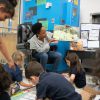Through a unique multi-year partnership with Baltimore City School’s Margaret Brent Elementary/Middle School, Johns Hopkins University has provided yearlong professional development support for teachers to apply evidence-based arts integration strategies in their teaching practice.
Building on earlier efforts to bring enhanced arts programming to the school, the partnership is working to create a “flagship” arts-focused curriculum, providing teachers with ongoing professional development in arts integration as well as support for both classroom and afterschool arts programs, including Single Carrot Theater and Baltimore Symphony Orchestra’s OrchKids.
The partnership has been made possible through support from the university’s Homewood Community Partners Initiative (HCPI), a stakeholder-driven community-development strategy comprising 10 neighborhoods around the Johns Hopkins Homewood campus, a key component of which is establishing core flagship curriculum and associated programming at two traditional public schools.
The focus on the arts is an outgrowth of research studies led by Dr. Mariale Hardiman, vice dean of academic affairs for the Johns Hopkins School of Education, and a team from the university’s Neuro-Education Initiative (NEI), which found that arts-infused teaching helps students retain information better than traditional teaching.
“Teaching requires purposeful techniques to help students master skills and concepts,” said Hardiman. “Embedding the arts into instruction is a natural way to enhance long-term retention and deeper learning.”
To showcase the impact of this arts integration teaching and learning partnership, the school held a “Celebration of the Arts and Literacy.” On April 26, 2018, Principal Pamela Smith and more than 250 students, parents, teachers and esteemed guests met to honor the extraordinary ways the school has woven the performing and visual arts in every classroom. Joining in the festivities were Dr. Hardiman; Sean Conley, City Schools’ chief academic officer; Andrew B. Frank, JHU special advisor to the president for economic development; Salem Reiner, JHU associate director of economic development; and Carolyn Freeland, JHU community schools consultant.
This showcase collected arts-integrated learning units developed by teachers through a series of training sessions in Dr. Hardiman’s research-based methodology, the Brain Targeted Teaching® Model. This framework emphasizes guidelines laid out in recent “whole child” educational policy, including nurturing empathy, global understanding, and arts exploration.
“This new approach to instruction offers teachers a vast new toolkit, in that the arts connect multiple disciplines, increase long-term retention, and build creative and critical thinkers,” said NEI Arts Integration Specialist Clare Grizzard, who is training the faculty. Pam Negrin, formerly of Young Audiences of Maryland, was also recently brought on board as a full-time, on-site arts integration coordinator.
To help bring the curricular transformation into every classroom, the school formed an Arts Integration Committee, headed by sixth-grade English language arts and social studies teacher Rachael Barillari. “It takes a significant effort for teachers to find a balance of what will work in the classroom,” said Barillari. “The ongoing training has been really important in exposing all of our colleagues to these wonderful methods that are not in the traditional curriculum.”
Regular committee meetings brought together faculty, administration, parents, and representatives from community organizations and Johns Hopkins University to brainstorm, troubleshoot, offer insights and share best practices. The committee also planned the recent celebration, with help from Sharicca Boldon, community coordinator for Strong City Baltimore, and Kim Wiggins, resident outreach manager of Live Baltimore.
Highlights of the evening included a rousing performance from the school’s 81-piece orchestra, comprising half of the school’s fourth, fifth, and sixth grade student body, according to OrchKids director Sandra Ragusa. Smith also hailed the ensemble as an exemplary success of arts integration. “To demonstrate how inclusive the arts are, we have a student who has not been with us two full weeks, but she’s playing a viola,” she said.
Visual arts classwork was presented in a gallery-style exhibit. Arts-integrated learning units displayed newly minted teaching methods and the Common Core Standards in art, science, and literature they support. A special storytelling station offered an engaging vehicle for literacy. Parents and visitors were also invited to assemble their own home-literacy toolkits using the school’s arts-oriented learning materials.
The community-school-university partnership also believes that the arts-integration school model can serve as a motivating factor for households to send their children to Margaret Brent, both those living within the school’s neighborhood zone as well as those in other parts of the city.
“We’re really excited to have an arts-integrated school in the neighborhood,” said Geoff Delanoy, a parent volunteer who has two kids at the school. “The simplest way I can express it is that the arts help make the content stick.”

